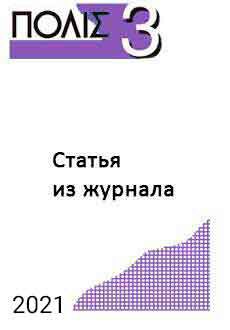Online shop of "Polis. Political Studies" Journal
We in the world, the world in us
Koktysh K.E. Belarus: A New Geopolitical Reality? – Polis. Political Studies. 2021. No. 3. P. 91-110. (In Russ.).
150 руб.
The scaled post-electoral protests in Belarus raised a number of questions both in practice and in political theory. Was it just one more attempt at a “color revolution”, or was I an outburst that can be logically explained in terms of internal contradictions and mistakes made by the authorities? Why did the level of political technologies used by the protesters, which was high, not affect the outcome of the Belarusian confrontation? Among the reasons for the latter, the author singles out the protest’s failure at creating its own “symbolic space” which could become a semantic and “power” center, the failed attempts to split the ruling elite after which the enemy was declared as being “the system as a whole”, and the negative concept of freedom adopted by the protest, which in fact goes back to Voltaire’s tradition, within which freedom is “something that was lost” when state emerged but not something that can be defined in a positive way. It is easy to see that within such a cognitive framework the enemy of freedom can be clearly identified (this being the state), but it is completely unclear what freedom is and how and at what point it can be obtained. The uncertainty of this concept quickly transformed into the certainty of nationalism, and the protest began to take shape as a “confrontation of the new nation” with the “obsolete state”. At the same time, there was not, and could not be, any positive program of “tomorrow”. The state also suffered losses: “pro-Belarusian” ideology (previously a synthesis of the concept of order and the concept of cultural nationalism) split, leaving the state with a “naked” concept of order, while the protesters privatized nationalism. In addition, as part of the pragmatism of normalization in the West’s direction after 2014, the Belarusian regime actually turned a blind eye to the loss of its own dominance in the information space. As a result, the struggle took the form of a confrontation between “ideas without institutions versus institutions without a national idea”, i.e., the idea of a new nationalism and the idea of order. The latter turned out to be a win for the state and a loss for the protest: the protest idea eventually degraded to a simulacrum, the meaningful management of which is hardly possible. The author also questions how the “reassembly” of the Belarusian political system can occur – it is supposed to start with the adoption of amendments to the constitution. The configuration of latter will most likely take the form of an increased role for parties, which runs the risk that the current confrontation may not be resolved but transformed, acquiring other forms. In this regard, Russia will have to add inter-party diplomacy to the institution of inter-parliamentary diplomacy.
The scaled post-electoral protests in Belarus raised a number of questions both in practice and in political theory. Was it just one more attempt at a “color revolution”, or was I an outburst that can be logically explained in terms of internal contradictions and mistakes made by the authorities? Why did the level of political technologies used by the protesters, which was high, not affect the outcome of the Belarusian confrontation? Among the reasons for the latter, the author singles out the protest’s failure at creating its own “symbolic space” which could become a semantic and “power” center, the failed attempts to split the ruling elite after which the enemy was declared as being “the system as a whole”, and the negative concept of freedom adopted by the protest, which in fact goes back to Voltaire’s tradition, within which freedom is “something that was lost” when state emerged but not something that can be defined in a positive way. It is easy to see that within such a cognitive framework the enemy of freedom can be clearly identified (this being the state), but it is completely unclear what freedom is and how and at what point it can be obtained. The uncertainty of this concept quickly transformed into the certainty of nationalism, and the protest began to take shape as a “confrontation of the new nation” with the “obsolete state”. At the same time, there was not, and could not be, any positive program of “tomorrow”. The state also suffered losses: “pro-Belarusian” ideology (previously a synthesis of the concept of order and the concept of cultural nationalism) split, leaving the state with a “naked” concept of order, while the protesters privatized nationalism. In addition, as part of the pragmatism of normalization in the West’s direction after 2014, the Belarusian regime actually turned a blind eye to the loss of its own dominance in the information space. As a result, the struggle took the form of a confrontation between “ideas without institutions versus institutions without a national idea”, i.e., the idea of a new nationalism and the idea of order. The latter turned out to be a win for the state and a loss for the protest: the protest idea eventually degraded to a simulacrum, the meaningful management of which is hardly possible. The author also questions how the “reassembly” of the Belarusian political system can occur – it is supposed to start with the adoption of amendments to the constitution. The configuration of latter will most likely take the form of an increased role for parties, which runs the risk that the current confrontation may not be resolved but transformed, acquiring other forms. In this regard, Russia will have to add inter-party diplomacy to the institution of inter-parliamentary diplomacy.
 English
English Русский
Русский

Reviews
There are no reviews yet.